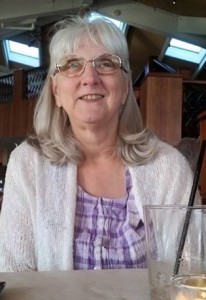 This is a verbatim copy of an extraordinary blog post last year, which I updated several times.
This is a verbatim copy of an extraordinary blog post last year, which I updated several times.
It was a year ago today that orthopedist Howard Luks @HJLuks replaced both my wife Ginny’s knees in one day, and as you’ll read, his method is so incredible that not only did she get no transfusions, her bandage didn’t even need to be changed until the follow-up visit weeks later. And as you’ll see, the progress of her recovery was extraordinary.
Want new knees? Read how Howard does it. Know anyone who’s considering new knees? Share this with them, please! I even gave it a memorable URL: bit.ly/ginnyknee
July 7, 2015
On Facebook Friday I posted this picture of my wife Ginny, saying “There is an astounding story behind this photo. Details Monday.” Well, it’s Monday.
As you read this, bear in mind, your mileage may vary – everyone’s different, this wouldn’t be appropriate for everyone, and Ginny herself played a big part in it.
The astounding story:
In this photo we were out to dinner, nine days after Ginny had both knees replaced. She walked into the restaurant using only canes – no walker, no wheelchair. The surgeon is Howard Luks, the social media orthopedist (@HJLuks), whom I met on Twitter in 2009, and the surgical approach he used is called muscle-sparing (or “quad-sparing”) minimally invasive surgery, part of a larger package of methods he uses, described below. Bottom line:
- None of her muscles were cut
- She had no transfusions
- She has not needed to have any of her dressings changed
- She left the hospital on day 3, was discharged from rehab 8 days after surgery, and today on day 12 we’re returning to New Hampshire, to continue outpatient physical therapy from home.
Of course she’s still on pain meds, tapering down, and her endurance is of course limited. But she is basically functional and able to live on her own if she needed to, or rehab wouldn’t have discharged her.
Here’s a video of her walking around the hospital floor – 500’ – with a walker for balance (not leaning on it), less than 48 hours after leaving the O.R., and on the right, at rehab, walking with just canes, a week after the surgery:
She was discharged from rehab after demonstrating (among other things) that she can safely walk up and down a full flight of stairs … six days after the surgery. She can get herself into and out of bed, into and out of our Prius, etc. She’s not speedy at any of it but she’s functioning reliably.
(Of course I have Ginny’s permission to talk about all this. Also, I’m an e-tool geek and she’s not, so I’m the one using the tools discussed here.)
Again, everyone, please read this: your mileage may vary – everyone’s different, this wouldn’t be appropriate for everyone, and Ginny herself played a big part in it.
The part Ginny played, as an activated, engaged patient
In my speeches I talk a lot about “patient engagement” – the patient as an active partner in health and care – but usually I’m asking healthcare to listen to and welcome patient voices. The flip side is equally important: the patient stepping up and doing as much of the work as they can.
In joint replacements this is essential, because nobody but you (the patient) can do the physical work required to recover after the surgery, and it can be hard.
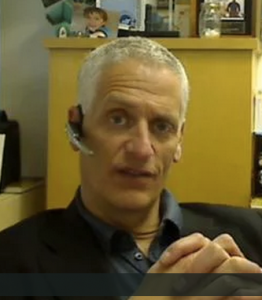
Howard (he insists on being called Howard) says that in his experience the biggest reason knee replacements fail is if the patient simply isn’t willing to do his or her part of the work. It hurts – he says “You know why mob guys hit you in the knees? Because knee injuries really hurt!“
Ginny was willing to do the work:
- An essential part was “prehab” (a play on “rehab”) – two weeks of physical therapy before surgery, to get in practice for what the muscles would need to do after.
- She also lost 20 pounds in the months leading up to the surgery, so her replaced knees would have less weight to lift and carry.
Another aspect is her choice of a surgeon who happened to be three hours from home. Ginny’s a retired veterinarian who’s done thousands of surgeries herself, and was on the New England Board of Veterinary Medical Examiners, where she was exposed over the years to many many doctors of varying degrees of excellence, so she has strong opinions about wanting someone good and decades of intuition about who that is. A few years ago she met Howard when we happened to be driving through his area, and when she decided surgery time had come, there was no question: “I want Howard to do it.”
Yes, my wife is an empowered, engaged, informed, activated patient. Imagine. (Unlike me, though, she doesn’t talk about it – she just does it.)
All of that happened before we learned about the new muscle-sparing approach. That turned out to be quite an unexpected bonus – we were prepared for the normal recovery that our friends and family had endured.
What it’s like to work with an “e-patient surgeon”
I’m best known for my relationship with my famous primary physician, Dr. Danny Sands. Nothing I say here about the very similar Howard Luks affects anyone else I’ve spoken of, including Dr. Sands, my oncologist David McDermott, my awesome urologist-surgeon Drew Wagner, my orthopedist Dr. Megan Anderson, my nurse practitioners Meeyoung Lee and Gretchen Chambers, all of whom are just tops, and fully encourage empowered patients. Yes, I remember their names and faces eight years later.
Howard Luks truly believes in making medicine more efficient. Like many docs I know, he’s suffering some from the changes in health policy and the sometimes obscene reimbursement rates he’s offered. (Know how much he gets paid by Medicaid for doing a knee replacement? $330! Can you believe that??) Installing their EMR and complying with Meaningful Use has cost his practice a big hit in productivity so far (appointment volume, and therefore income). But he sees the future and is pushing through into it, using whatever tools he can.
Cloud software tools
- He’s a big fan of Twistle, a secure (HIPAA-compliant) messaging system.
- This is a huge help if your doctor’s office(s) doesn’t / don’t have good, modern secure messaging; among other things, Twistle can include messages from multiple docs even if they work in different places. (It can integrate with EMR platforms, but most docs don’t consider that a necessity; Howard does, and he’s planning on doing it: “With machine learning and smart forms the platform can intelligently perform many useful functions.”)
- BUT, and it’s a big but, just remember that without such integration, Twistle messages aren’t visible in each doc’s “real” system where they work. (I’m starting to think “Who cares??” for most messages, but for seriously important information I’d want to be very careful about where the information lives.)
- He’s starting to use HealthLoop, which attempts to manage communicating each step in the plan to you before and after the surgery.
- [italic phrase added 7/7 per comment below] Personally I’m unimpressed with how HealthLoop has been implemented so far; the idea is great but it’s not ready for prime time: as with any other process automation tool, the whole team needs to be aligned with it, and the content and procedures need to be absolutely consistent, or it’s an automated mess. More than once HealthLoop disagreed with office staff, which in my view is worse than nothing.
- He’s happy to communicate by any medium – email or anything. My feeling is that anything we need to look up later needs to be in the secure message system, and of course anything confidential needs to be there. But for casual questions, he’ll use anything. (Just remember, if you don’t use an “official” communication tool with your providers, don’t expect a response in any particular timeframe. Providers have a life.)
Pre-visit communication
You could say Howard is nuts, because he’s so committed to sharing empowering information with everyone who needs it; he also knows how to do SEO optimization so his content can get found: his site gets 9,000 new visitors per day(!!!) and up to 20,000 pageviews/day from around the world. Let’s just say the vast majority of them are not his paying patients. :-)
Here’s an example of his approach: In my book Let Patients Help I said e-patients should ask “What’s your infection rate?” Howard not only welcomed the question (“average is 0.8%; mine is 0.6%”), he described the protocol he uses to minimize it. I asked “Is that on your website?? I didn’t notice it” and he said “It probably should be,” and now it is.
The evaluation appointment
- Prior to our first appointment I emailed him Ginny’s radiology images, so we didn’t need to take more images. (Howard gladly welcomed them, saving us time and saving everyone money.)
- Thanks to Beth Israel Deaconess, where our primary care is, for giving us a free CD of the images (at time of service) and for giving us free online access to the radiologist’s report!
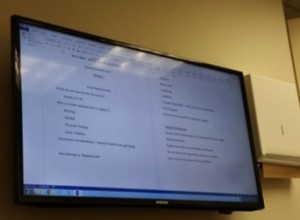 Howard’s practice has flat-screen displays on the wall of each exam room (right), so we can look at images together and we can watch what he’s doing in the EMR, while he does it.
Howard’s practice has flat-screen displays on the wall of each exam room (right), so we can look at images together and we can watch what he’s doing in the EMR, while he does it.
- He gave us a clipboard with a pad labeled “What We Discussed,” to take notes on.
Between visits, when questions come up
In my first book Laugh, Sing, and Eat Like a Pig (my cancer journal) I noted that my world-class oncologist Dr. David McDermott welcomes dialog, including in email: once when I apologized for what turned out to be a dumb question he replied “I am happy to field your questions.”
Howard is exactly the same. Ginny is less verbose (ahem), so with her permission I messaged Howard (sometimes several times a day), and every time he responded within a couple of hours. In short, he recognizes that when patient and family have questions, it’s a sign of engagement. Plus, he says, he understands “most people are too afraid to ask questions… so I offer platforms to communicate which are less imposing than sitting on a cold bench in my office with the clock ticking :-).”
There’s more to the package than this quad-sparing surgery
Personally, my mind is blown by this new surgical approach, but Howard quickly points out that Ginny’s extraordinary outcome is a result of a program that has many parts:
- Infection control (before, during and after surgery) (see his protocol, above)
- TXA (tranexamic acid) – The Mayo Clinic cites TXA’s use in emergency medicine (e.g. EMTs using it to stop blood loss in injuries), but Howard noted that cardiovascular surgeons have used it for decades, and now he is, in orthopedics. Result: “less blood loss, fewer transfusions, less blood received which leads to fewer infections.”
- TXA is also why she didn’t bleed enough to ever need her dressings changed, he says.
- An engaged patient who understands their role (their responsibility for doing the work)
- Includes doing the “prehab” as well as the rehab.
- A doc who understands the patient’s expectations. He will ask a patient what outcome they’re after, and won’t always recommend surgery, even if from the first description of symptoms that seems obvious.
- The surgical method (quad-sparing)
- Note: He says patients who get the usual surgical method do catch up eventually; the benefit is in faster recovery time. “People gain back their strength faster with a muscle sparing approach. Thus they can sustain a faster rehab.”
- Well, heck: I don’t know much about orthopedics, but I know people who’ve been out of week 12 weeks after having a single knee replacement, so being released from rehab in 8 days, functional, sure sounds like something worth knowing about as an option.
- Multi-modal pain management. Ginny received regional anesthesia during the surgery, and Howard injects the inside of the knee with a cocktail of meds to take advantage of pre-emptive analgesia. She’s now on four pain meds for different pain pathways.
- “Pain management is incredibly important in these cases,” he says, “because it affects how able the patient is to do the work and regain strength. But too often people overlook that not all pain is the same – you can’t treat it all with opiates.”
- Not to mention the horrid constipation that morphine, dilaudid etc can cause, sometimes bringing weeks of real suffering.
“All of that,” he says, “comes together to result in a better experience, fewer surprises and fewer complications.”
Astounding indeed. Every patient should know this option.
As I said: an astounding story, right?
Of course there are no guarantees, and problems do happen, and no two cases are identical … but wouldn’t you want to know about a new option that might have you functioning again five or six times sooner than the usual treatment, with a lot less pain?
I’m going to be blunt here about something I think is important: it’s not uncommon for a newer option like this to not be widely known, and thus not offered to patients. (Last month I spoke at a conference where someone mentioned this type of knee replacement, and said that it’s only used 18% of the time.)
I applaud the surgeons, like Howard, who have taken the steps to learn this surgical method (including the comprehensive package he uses). Honestly, it’s deeply moving to see my wife doing so well – she’s not out of the woods yet, but doing so well – and I want to help spread the word, so docs who offer this method can be rewarded by eager patients – and perhaps so surgeons who don’t know it yet will be inspired to learn.
Updates
| Day 14 – first day at PT, getting evaluated. (He said “Boy, your legs are strong!!”) | Day 19 (July 13) – third day of PT. |
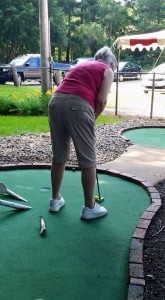 Update day 17: mini-golf
Update day 17: mini-golf
Saturday, July 11: We’ve only been home from New York for five days, and she says “I want to play mini-golf.”
I said “Are you nuts??” and texted Dr. Luks. He replied “I side with Ginny!”
So off we go – nothing but a putter to serve as her “cane.” The Facebook post with more info and pix is here. (It’s a public post – no login required)
Update day 30: approved to drive
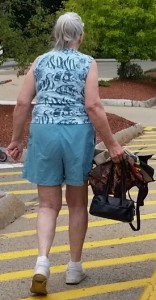 July 24: Surgery was 30 days ago. At today’s regularly scheduled physical therapy session she got approved as safe to drive. So, on the way back, off to the grocery story (no cane) (left), and she drove home (below).
July 24: Surgery was 30 days ago. At today’s regularly scheduled physical therapy session she got approved as safe to drive. So, on the way back, off to the grocery story (no cane) (left), and she drove home (below).
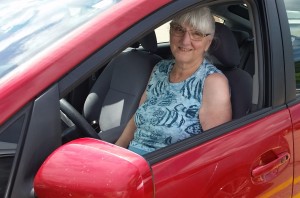
The important thing about this approval is that it means the legs can be trusted to respond in an emergency. That’s no small issue.
The celebratory blog post is here, including these photos. Look Ma – no canes! No bandages! Just walkin’ an’ drivin’ unassisted!
Update day 48: stairs with no hands
Well. Last Tuesday (day 41) we visited Howard for the six week follow-up, and he said everything looked good and she’s doing great, and it’s time for her to start tapering off the dilaudid (opiate / pain med). Since then she’s had a total of two tablets, each before a PT session… none since last Friday (4.5 days)… and today she decided to try walking the basement stairs in a way she hasn’t been able to do for ten years.
(@MightyCasey, this was spontaneous and I forgot to turn the phone horizontal – sorry. I was excited. These replacement knees are lookin’ pretty darn healthy for seven weeks out.:-))


Leave a Reply